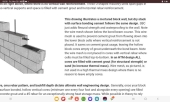Welcome to Permies, Carson! That is a very long list of questions, too many to respond to in one post. I will hit a few highlights to start.
Masonry heater code calls for 8" minimum clearance to a ceiling.
If the basement slab was poured by a commercial house builder, it is probably nominal 4" thick. It may be strong enough, but as you have no height restriction I would start with a 4" reinforced concrete slab a bit larger than the bell footprint, on top of the existing slab.
Professionals generally use straight hard firebrick for firebox walls, without added coatings. As the door will generally be a bit smaller than the firebox, you should not have a lot of sliding wood, and you should not throw logs in such that they might hit the back wall or ceiling. The load should have a couple of inches clear to the back wall.
I have not heard of anyone using an expansion joint between core and structural base, and I do not think one is needed between lower common brick and upper firebrick in the inner bell. The part most likely to be affected by heat is the top, and firebrick expands less than common brick when heated. The heat gradient is fairly uniform from top to bottom, especially in a first gen batch box.
I would definitely allow for expansion if using angle supports for the roof; less so with firebrick slabs.
As long as you maintain clearances to the ceiling and possibly a heat shield on the ceiling, I would not worry about insulating between skins.
For water soluble mortar, you want a clay-sand mix. Runny and very fine sand for thin joints, conventional mortar consistency and don't worry about the sand size for wide joints. This is what stove masons commonly use, so I don't think you need to worry about longevity.
I think your flue routing would be safe for your use, but if somebody ever took out the RMH and put in a standard wood stove, it would be very dangerous, so I think it is best to follow code for the flue and roof penetration.








